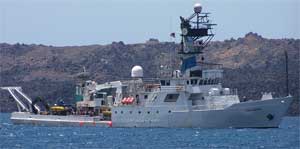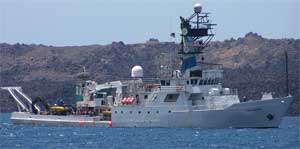 NARRAGANSETT, R.I. – October 18, 2011 – The return of the University of Rhode Island’s research ship Endeavor to port today after completing its 500th expedition has prompted its scientists and crew to reminisce about some of their favorite moments aboard the ship.
NARRAGANSETT, R.I. – October 18, 2011 – The return of the University of Rhode Island’s research ship Endeavor to port today after completing its 500th expedition has prompted its scientists and crew to reminisce about some of their favorite moments aboard the ship.
The 185-foot long ship, owned by the National Science Foundation but operated by URI since its commissioning in 1976, was one of the first in the nation to be designed as an oceanographic research vessel, rather than be converted from a Navy vessel. It has taken thousands of scientists and students throughout the Atlantic and Pacific oceans, to the Mediterranean and Black seas, and even to the Arctic. Endeavor’s 500th cruise, which departed last Wednesday, took a complement of scientists and students to the Sargasso Sea to study plankton, ocean currents, and marine pollutants.
Oceanography Professor Tom Rossby, who has been aboard the Endeavor more than any other scientist, said that the ship performs well in challenging conditions. “Once we were stuck in the Gulf Stream with winds steadily over 40 knots, peaking at 60 knots by the third day,” recalled Rossby, who was aboard the Endeavor for its 500th cruise. “The seas can build up plenty over this time. We couldn’t do a thing; the seas were absolutely towering over us. It became clear that the Endeavor is a very seaworthy and well-riding ship.”
Added Marine Technician Bill Fanning, who has traveled aboard Endeavor more than 60 times, “there were many times we would ride out a storm on Georges Bank in winter and work in the lulls. Other ships would have gone in, or not come out at all. She’s a good ship.”
Even good ships can have difficulty in some storm conditions, however. Oceanography Professor Ted Durbin recalls a cruise to Georges Bank one February that was besieged by several storms one after another. Ice formed on the deck, it became hazardous to do even the simplest of measurements, and the captain decided to take refuge in Portland harbor for several days.
“On a 16-day cruise, we only got about two or three days of actual work done,” said Durbin, who has conducted studies aboard Endeavor at least 20 times in his career. “But while we were in Portland, Bob Dylan and Natalie Merchant were performing, so we got to see a good show.”
His favorite memory occurred while studying the tiny marine organisms called copepods that endangered North Atlantic right whales feed upon.
“It was evening and the water was very calm, and then all of a sudden the sea turned red from the copepods being chased to the surface by krill, and a mass of seabirds showed up out of nowhere to feed on the copepods,” he recalled. “It was pretty impressive.”
When asked for his favorite destination aboard Endeavor, Fanning could not make up his mind, listing the waters off Norway, France, Iceland, Brazil, Peru, and Hawaii as among his favorites, noting that all are “a great place to start a vacation.”
“It’s the perfect size ship for the work I do,” said Durbin, who studies plankton in the waters off the Northeast U.S. “It’s stable, it has large labs, you can do multi-investigator projects at the same time, and the marine technicians that help the scientists are very good. I think it’s a great ship.”
After 35 years and 500 research cruises, URI officials are anticipating the ship’s eventual retirement and looking toward the future.
“We hope to continue to operate the Endeavor for at least the next five years,” said Dennis Nixon, associate dean of the Graduate School of Oceanography. “We plan to compete for a new ship in the near future, which we hope will be completed before the Endeavor’s anticipated retirement date.”

